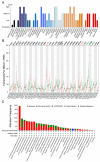PHF20L1: An Epigenetic Regulator in Cancer and Beyond
- PMID: 40723918
- PMCID: PMC12292733
- DOI: 10.3390/biom15071048
PHF20L1: An Epigenetic Regulator in Cancer and Beyond
Abstract
Plant homeodomain (PHD) finger protein 20-like 1 (PHF20L1) is a novel epigenetic "reader" that specifically recognises histone post-translational modifications (PTMs) via its Tudor and PHD finger domains, thereby regulating chromatin remodelling, DNA damage repair, and oncogene transcriptional activation. This review comprehensively summarises the role of PHF20L1 in various cancers, including breast, ovarian, and colorectal cancers, as well as retinoblastomas, and elucidates its molecular mechanisms of action in cancer pathogenesis. Accumulating evidence indicates that PHF20L1 is upregulated in these malignancies and drives tumour progression by promoting proliferation, metastasis, and immune evasion. Furthermore, PHF20L1 orchestrates tumour-related gene expression by interacting with key epigenetic complexes. Given its unique structural features, we propose novel strategies for developing small-molecule inhibitors and combinatorial therapies, providing a theoretical basis for targeted epigenetic regulation for precision treatment. Future research should further investigate the molecular regulatory networks of PHF20L1 in different cancers and other human diseases and focus on developing specific small-molecule inhibitors to enable precision-targeted therapies.
Keywords: PHF20L1; cancer; epigenetic regulation; histone methylation; targeted therapy.
Conflict of interest statement
The authors declare no conflicts of interest.
Figures





Similar articles
-
A narrative review of epigenetic marker in H3K27ac and its emerging potential as a therapeutic target in cancer.Epigenomics. 2025 Mar;17(4):263-279. doi: 10.1080/17501911.2025.2460900. Epub 2025 Feb 21. Epigenomics. 2025. PMID: 39981972 Review.
-
Research Progress on the Functional Regulation Mechanisms of ZKSCAN3.Biomolecules. 2025 Jul 14;15(7):1016. doi: 10.3390/biom15071016. Biomolecules. 2025. PMID: 40723888 Free PMC article. Review.
-
The LncRNA STEAP3-AS1 promotes liver metastasis in colorectal cancer by regulating histone lactylation through chromatin remodelling.J Exp Clin Cancer Res. 2025 Jul 15;44(1):205. doi: 10.1186/s13046-025-03461-0. J Exp Clin Cancer Res. 2025. PMID: 40665344 Free PMC article.
-
Systemic treatments for metastatic cutaneous melanoma.Cochrane Database Syst Rev. 2018 Feb 6;2(2):CD011123. doi: 10.1002/14651858.CD011123.pub2. Cochrane Database Syst Rev. 2018. PMID: 29405038 Free PMC article.
-
[Epigenetics' implication in autism spectrum disorders: A review].Encephale. 2017 Aug;43(4):374-381. doi: 10.1016/j.encep.2016.07.007. Epub 2016 Sep 28. Encephale. 2017. PMID: 27692350 French.
References
Publication types
MeSH terms
Substances
Grants and funding
LinkOut - more resources
Full Text Sources
Medical
Miscellaneous

